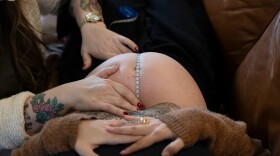Speaker 1: (00:00)
A Mart and a bird face the aftermath of a destructive wildfire. That's the premise of the new children's book once upon a forest, capturing a world steeped in nature, the book's story is told solely through images with a powerful message of hope for the future local author and illustrator. Pam Fong spoke with midday edition. Co-host Jade. Henman about her new children's book once upon a forest, which comes out today. Here's that interview, Pam. Welcome.
Speaker 2: (00:30)
Hi Jade. Thanks so much for having me.
Speaker 3: (00:32)
So despite being a book for young children, your book really deals with some serious themes. Um, tell us more about the book and why you felt a picture book was the best way to tell this story. Well,
Speaker 2: (00:44)
I think kids understand the world that they live in and they see kind of the news and all the forest fires that are going on and they're processing it themselves just like we do as adults. And so I really wanted to write a book that helps them do that. Helps them realize that yes, forest fires are devastating, but that there's hope. And that nature does renew itself sometimes with a little help from forest creatures. But I thought it was a message that would help children and adults reflect on kind of our, uh, the consequences of humans, um, when they come, when they interact with nature.
Speaker 3: (01:25)
So in your process of telling these stories, do you first come up with words or pictures?
Speaker 2: (01:30)
It depends on the story. Each story is different. I have stories where the words come to me first. Maybe it's just a sentence or maybe it's a whole paragraph. Sometimes it's just the image. It could be one character, or it could be a scene for this one in particular, the Marmite, the main hero, um, came to me first and, um, I just wanted to draw this character. It was just calling for me to draw it and I didn't have a story around it, but once it kind of took shape, I had a little conversation with this drawing and the rest of the story followed.
Speaker 3: (02:06)
What originally interested you in picture books?
Speaker 2: (02:10)
I love kids. I think they're amazing. They're my favorite type of people. And so I thought, you know, it's such a huge responsibility to inspire kids when they're at this age, when they're thinking about the world and they have unlimited possibilities. And so it it's a daunting responsibility, but one that I felt like, you know, I would love to have just a little hand in because picture books were so influential in my life. I came over from Taiwan at a very, very young age and we didn't speak the language. So the library was kind of the great equalizer for my family. We went there and then, and everyone was quiet, no one spoke. So we were all kind of, um, in the same boat, you know, just being quiet in the library and there, I discovered picture books. And of course, I didn't know the language enough. So I gravitated to the picture books that were wordless because I could put the story together myself. And that was a great comfort to me. It made me feel more included and less alone in this new country
Speaker 3: (03:15)
In telling your stories through pictures and rich colors. I mean, does that influence the stories that you like to tell? Yes, it
Speaker 2: (03:23)
Does. I think for this one in particular, I kept it mostly black and white because when you go into a forest scene, there is so much to take in. There are so many layers and the forest goes in so deep. It's very, very hard to, to capture all the, those little details without, uh, losing focus on the main characters. So this was a very conscious decision to keep it black and white, to leave a lot of white space and to give the color only to, um, the elements of nature, which is the third character in this book, you have the marm and bird and the nature itself. And so I didn't want nature being lost in all of that, especially when you're trying to create a four scene. And there's so much to look at
Speaker 3: (04:12)
And, and being that this is an audio interview. I urge listeners to go to kpbs.org, to see the visual imagery from this book for themselves. How would you describe the art style and why did you choose it for once upon a forest?
Speaker 2: (04:26)
I tend to draw realistically using values. I love black and white. Although a lot of my other works, my other books are in full color, but they have a minimal palette. So I like limiting myself to a limited palette in order to create harmony in the images. I dunno, I would describe it as a, a little realistic, but still playful in that, uh, illustrate a quality I'm trying to capture.
Speaker 3: (04:54)
How do you approach tackling serious topics such as climate change and habitat destruction? Uh, without over warming little readers,
Speaker 2: (05:02)
Once upon a forest is not really about a forest fire. It's about the hope that happens afterwards. You never really see the fire. Um, you see smoke. And so you never really see, you know, the blaze, the smoke is also very whi and it's surrounded by a lot of white space. So in that way, I'm hoping that, you know, the kids will get it without having to, to see it. And then we go quickly, quickly into cleaning up and restoring the forest. So the fire scene really is, uh, reserved for one spread. So very limited.
Speaker 3: (05:38)
I'm curious, what are some children's books and authors that you love as a child? Oh,
Speaker 2: (05:43)
So, um, I discovered this one book it's called max and it's by Italian illustrator. I can't recall the, his name off the top of my head. It's a wordless picture book and he did a series and it's all based on this character, uh, a little fuzzy character named max. And I discovered this in the library when I was very young and I picked up this book, I checked it out so many times that eventually they decommissioned it because I had worn it out so much and I kind of grew up and I forgot. I, I, I always remembered max, but I didn't, I didn't have a copy of the book and fast forward 28 years and we have the internet and I thought, one day, gosh, I'm gonna do, do a quick search and see if I can find this book again. And so I looked up fuzzy creature max and his face came up and I rediscovered that this creature was a marm of all things. And so I was just kind of blown away. So I feel like maybe a Marmite has been talking to me from a very young age,
Speaker 3: (06:51)
I think so. So what do you hope children will ultimately gain from this book?
Speaker 2: (06:58)
One of my main reasons for, um, spending so much time to create this book and drawing it in the way I did was that I wanted them to want to go out into the forest. I'm a avid hiker myself, and I know how much walking through the forest and walking on mountain trails has given me. And I hope that kids get excited about maybe going out and seeing forest scenery, maybe running into a Marmite and looking at, uh, nature from this very, very special place that is the forest. So I, I paid particular attention to trying to create, um, an inviting scene that kids will want to explore in their real world.
Speaker 3: (07:44)
I've been speaking with author and illustrator, Pam Fong about her new children's book once upon a forest published by random house children's book, which comes out today. Congratulations on the new book. And thank you for speaking with us about it, Pam.
Speaker 2: (07:57)
Thank you so much, Jay. A pleasure
Speaker 1: (08:00)
That was author and illustrator. Pam Fong speaking with K PBS's Jade Henman Fong will be signing copies of her book in person at diesel, a bookstore in Del Mar on Saturday, February 19th at 3:00 PM.









